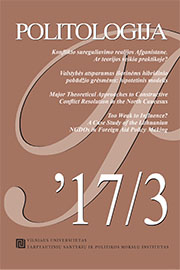Konflikto sureguliavimo realijos Afganistane. Ar teorijos veikia praktikoje?
Conflict Resolution in Afghanistan. Do Theories Work in Practice?
Author(s): Donatas PalavenisSubject(s): Political Theory, Government/Political systems, Security and defense, Geopolitics, Peace and Conflict Studies
Published by: Vilniaus universiteto leidykla & VU Tarptautinių santykių ir politikos mokslų institutas
Summary/Abstract: The ongoing conflict in Afghanistan poses a great danger to the Afghanistan state itself as well as for the neighboring countries. A decreasing interest from the United States of America, NATO and other key players due to a long war and other geopolitical challenges will leave Afghanistan with the minimum outer support for the future. The science of conflict resolution is offering a variety of theories that could lead endless wars and conflicts to an end. The ongoing conflict in Afghanistan is challenging those theories, while the resolution is crucial for the Afghanistan people right now. But are those theories reflected in the current actions of the US, NATO and Afghanistan governments? And do those theoretical actions lead to a better future regarding conflict resolution? The purpose of this article was to analyze the current policies of third parties influencing the current conflict in Afghanistan to determine the most relevant conflict prevention theory that could support conflict resolution most effectively in the future. To achieve the mentioned purpose, the following tasks were designed. First, the most relevant conflict prevention theories, applicable to the Afghanistan case, were analyzed and the main characteristics were identified. Secondly, the actions of NATO, US and Afghanistan, connected to the conflict resolution efforts, were identified and analyzed. After that, actions mentioned above were compared with theoretical approaches from different theories and certain trends were detected. Later on, research was focused to detect particular elements that were relevant to each theory and further actions concentrated on identifying the trend of these elements for each theory, while doing a comparative comparison analysis, which was based on selected timeframes. Afterward, the trends for each theory were compared and – by doing this – the most applicable theory was identified that could be later used in practice to resolve the current conflict. Research showed that: 1. All conflict prevention theories showed that resolution is possible only if all parties are involved in the processes and practically commit to actions. Currently this is not the case in Afghanistan. 2. Some conflict resolution theories consider similar actions that currently the NATO, US and Afghanistan governments are using in the region. 3. One of the analyzed conflict resolution theories could be applied practically in the Afghanistan case. The conflict prevention theory is the most flexible and has the widest action set in comparison with other theories. 4. The conflict prevention theory reflects the current US actions in Afghanistan, when the decreasing US support for the Afghanistan government in security, governance and in other sectors influences the weakening security situation. The effectiveness of conflict prevention theory is low due to the Taliban’s absence in the negotiations, and this fact does not influence any recognition that the most relevant theory that could support current conflict resolution in the most effective way in Afghanistan is the conflict prevention theory.
Journal: Politologija
- Issue Year: 2017
- Issue No: 3 (87)
- Page Range: 3-44
- Page Count: 42
- Language: Lithuanian

